Monitoring the NOAA Operational VIIRS RSB and DNB Calibration Stability Using Monthly and Semi-Monthly Deep Convective Clouds Time Series
Abstract
:1. Introduction
2. VIIRS SDR Products Used
| Band | Center Wavelength (µm) | Spatial Resolution at Nadir (m) | SNR/NEdT (Spec) | SNR/NEdT (On-Orbit) | |
|---|---|---|---|---|---|
| VIS/NIR | M1 | 0.411 | 750 | 316 | 1045 |
| M2 | 0.444 | 750 | 409 | 1010 | |
| M3 | 0.486 | 750 | 414 | 988 | |
| M4 | 0.551 | 750 | 315 | 856 | |
| M5 | 0.672 | 750 | 360 | 631 | |
| I1 | 0.639 | 375 | 119 | 214 | |
| M7 | 0.862 | 750 | 340 | 631 | |
| I2 | 0.862 | 375 | 150 | 264 | |
| SWIR | M8 | 1.238 | 750 | 74 | 221 |
| M9 | 1.375 | 750 | 83 | 227 | |
| M10 | 1.602 | 750 | 342 | 586 | |
| I3 | 1.602 | 375 | 6 | 149 | |
| M11 | 2.257 | 750 | 10 | 22 | |
| DNB | DNB | 0.700 | 750 | ≥6@Lmin | >9 across scan after degradation |
| TEB | M15 | 10.729 | 750 | 0.26 K | 0.10 K |
| I5 | 11.469 | 375 | 1.7 K | 0.43 K |

3. The DCC Technique for VIIRS
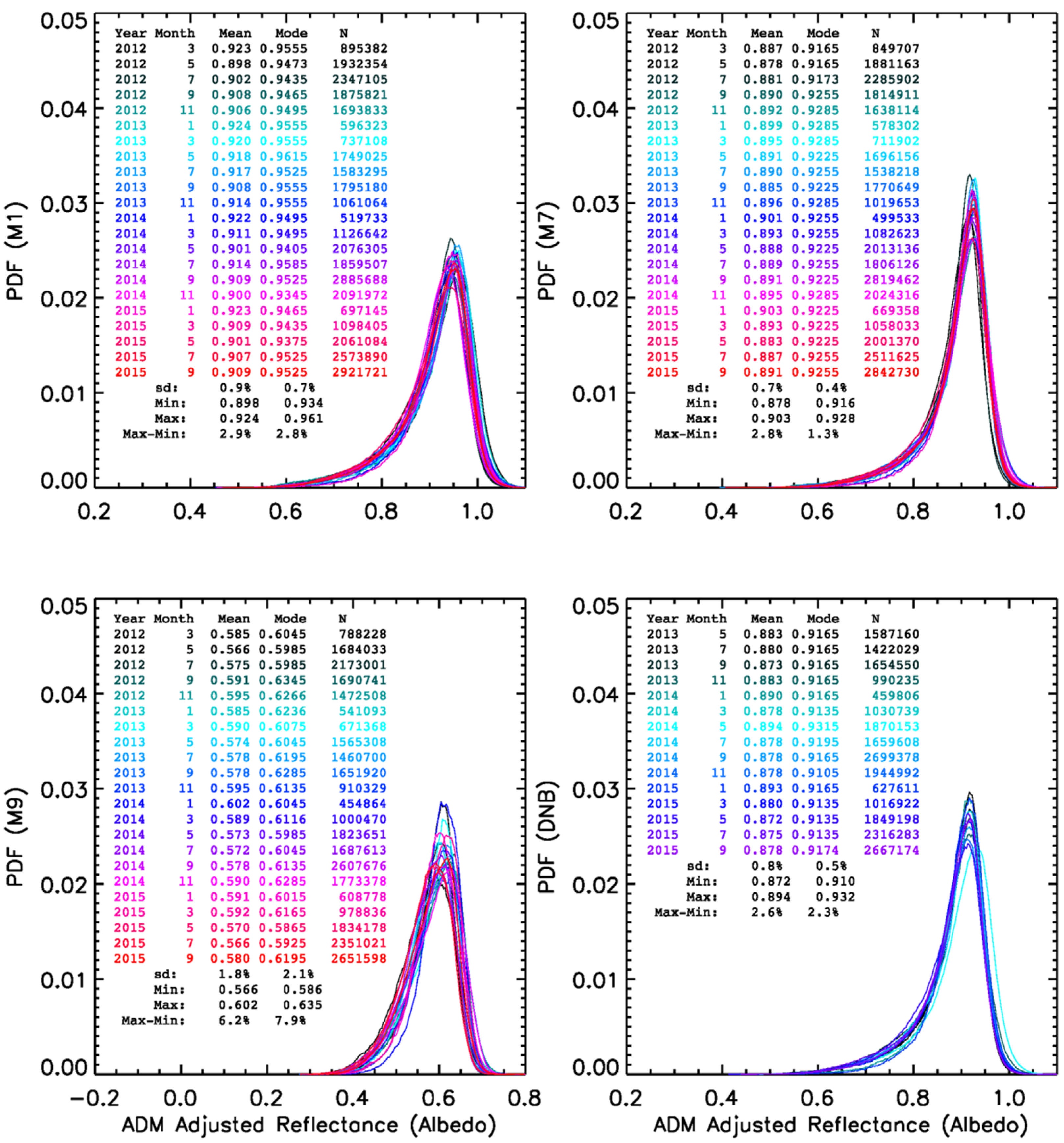
| Band | DCC Mode | DCC Mean | |||||
|---|---|---|---|---|---|---|---|
| Avg | sd (%) | Max−Min (%) | Avg | sd (%) | Max−Min (%) | ||
| VIS/NIR | M1 | 1.018 | 1.0 | 4.124 | 0.977 | 1.0 | 3.825 |
| M2 | 1.009 | 1.1 | 4.461 | 0.967 | 1.1 | 5.107 | |
| M3 | 1.005 | 1.0 | 4.178 | 0.963 | 1.0 | 4.187 | |
| M4 | 0.973 | 0.9 | 4.009 | 0.931 | 0.9 | 3.534 | |
| M5 | 1.002 | 0.8 | 3.294 | 0.959 | 0.7 | 2.804 | |
| I1 | 0.963 | 0.8 | 3.740 | 0.919 | 0.9 | 3.544 | |
| M7 | 0.991 | 0.6 | 2.725 | 0.955 | 0.7 | 2.637 | |
| I2 | 0.991 | 0.6 | 1.816 | 0.954 | 0.8 | 3.355 | |
| SWIR | M8 | 0.704 | 1.0 | 3.834 | 0.698 | 1.0 | 3.250 |
| M9 | 0.655 | 1.7 | 6.387 | 0.625 | 1.7 | 6.777 | |
| M10 | 0.230 | 3.1 | 14.332 | 0.232 | 3.1 | 10.342 | |
| I3 | 0.230 | 3.2 | 13.930 | 0.232 | 3.1 | 10.050 | |
| M11 | 0.371 | 2.2 | 8.398 | 0.371 | 2.2 | 7.199 | |
| DNB | DNB | 0.982 | 0.8 | 3.361 | 0.944 | 0.9 | 3.110 |
| Band | DCC Mode | DCC Mean | |||||
|---|---|---|---|---|---|---|---|
| Avg | sd (%) | Max−Min (%) | Avg | sd (%) | Max−Min (%) | ||
| VIS/NIR | M1 | 0.950 | 0.8 | 3.157 | 0.911 | 0.8 | 2.961 |
| M2 | 0.942 | 0.8 | 4.461 | 0.902 | 1.0 | 4.782 | |
| M3 | 0.938 | 0.8 | 4.158 | 0.897 | 0.9 | 4.232 | |
| M4 | 0.908 | 0.6 | 2.972 | 0.868 | 0.7 | 3.606 | |
| M5 | 0.936 | 0.4 | 1.924 | 0.894 | 0.6 | 2.756 | |
| I1 | 0.898 | 0.5 | 2.004 | 0.856 | 0.8 | 3.407 | |
| M7 | 0.924 | 0.4 | 1.299 | 0.891 | 0.7 | 2.803 | |
| I2 | 0.924 | 0.4 | 1.624 | 0.889 | 0.8 | 3.227 | |
| SWIR | M8 | 0.656 | 1.1 | 3.938 | 0.650 | 1.1 | 3.378 |
| M9 | 0.611 | 1.9 | 7.860 | 0.582 | 1.8 | 6.628 | |
| M10 | 0.214 | 3.5 | 14.478 | 0.216 | 3.3 | 10.862 | |
| I3 | 0.214 | 3.3 | 14.037 | 0.216 | 3.3 | 11.024 | |
| M11 | 0.345 | 2.6 | 10.427 | 0.346 | 2.5 | 8.065 | |
| DNB | DNB | 0.917 | 0.5 | 2.291 | 0.881 | 0.8 | 3.701 |
4. Results and Discussions
4.1. Calibration Stability for VIS/NIR M-Bands
4.1.1. Monthly VIS/NIR DCC Time Series
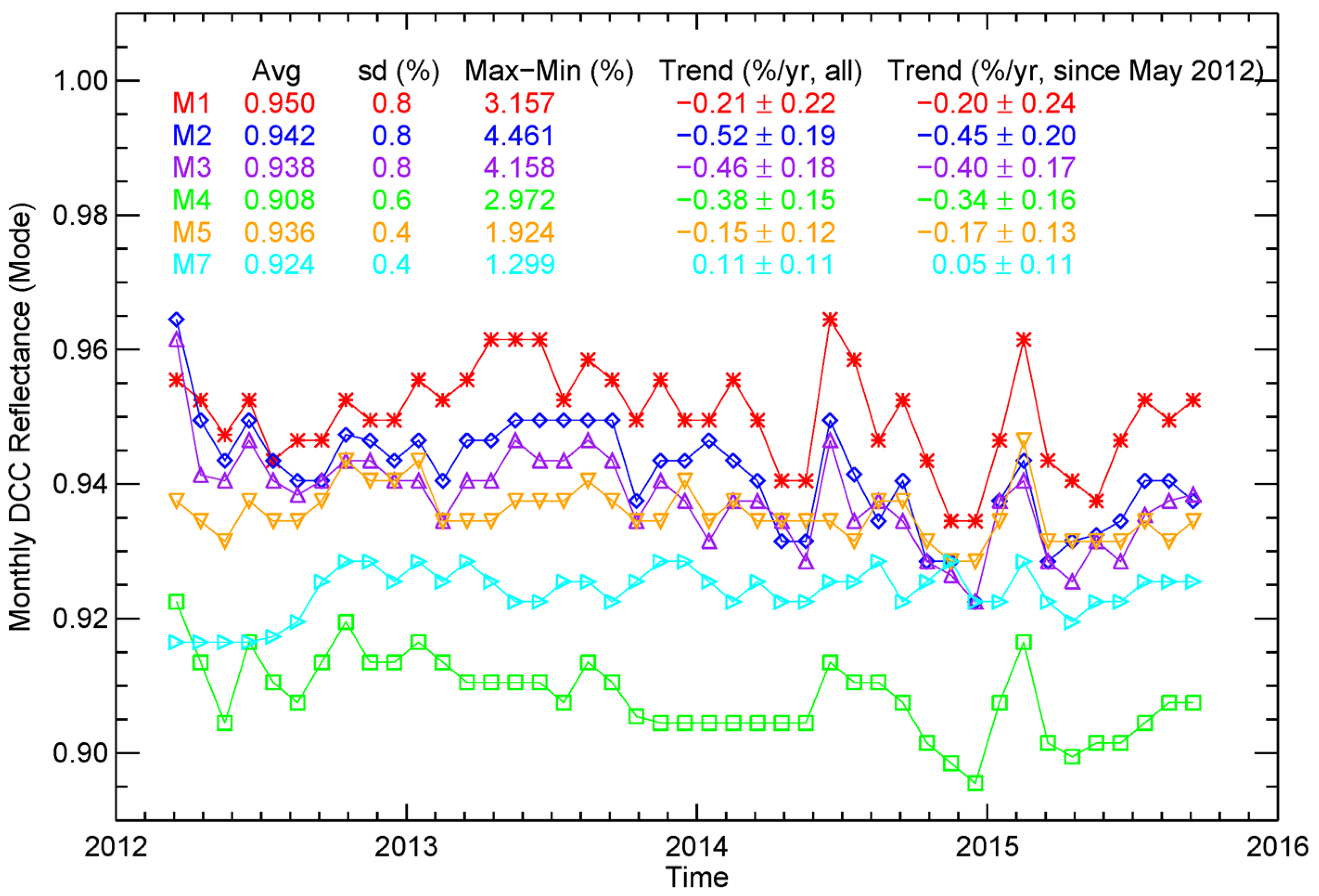

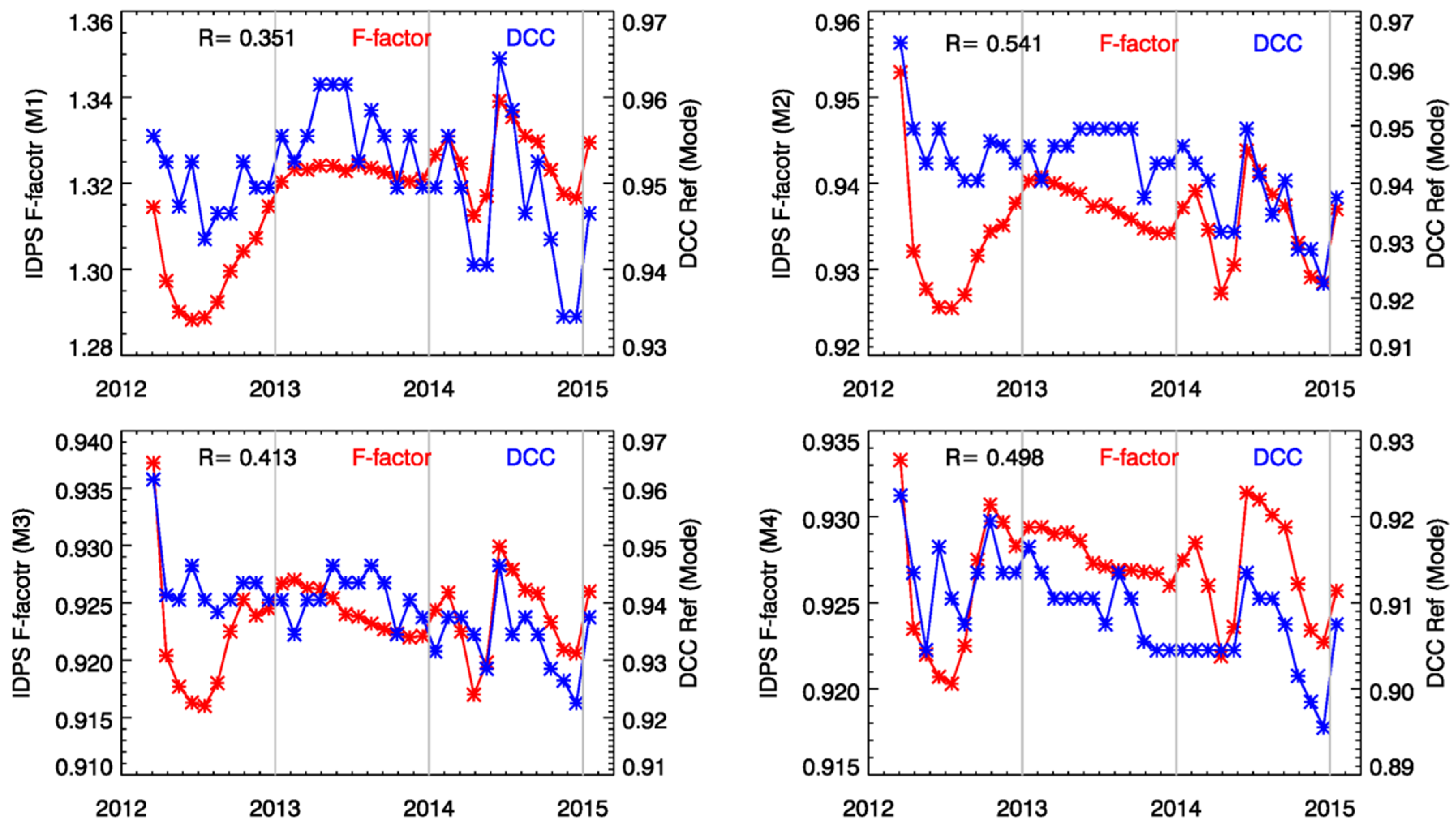
4.1.2. Semi-Monthly VIS/NIR DCC Time Series
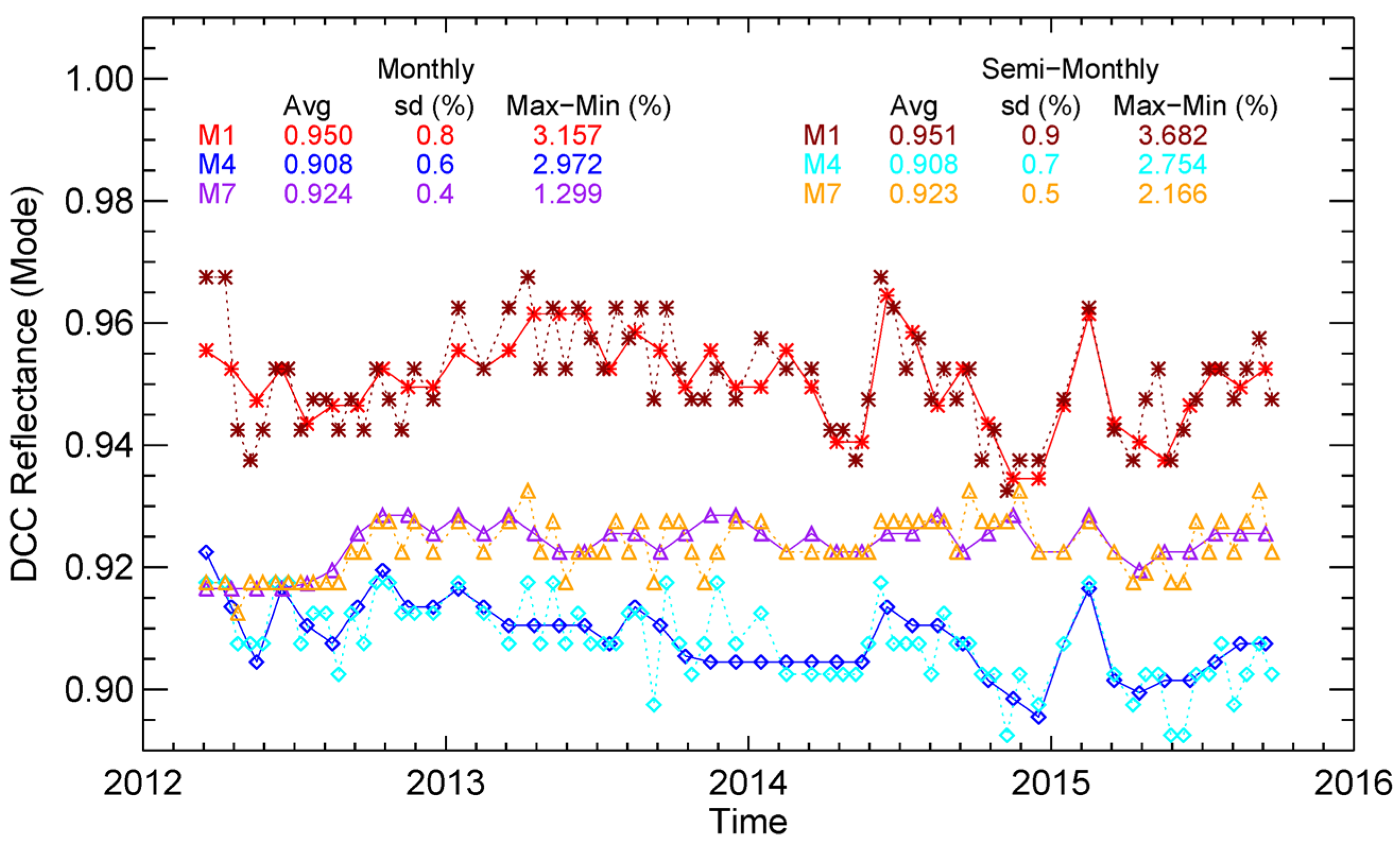
4.1.3. DCC Mean Band Ratio Times Series
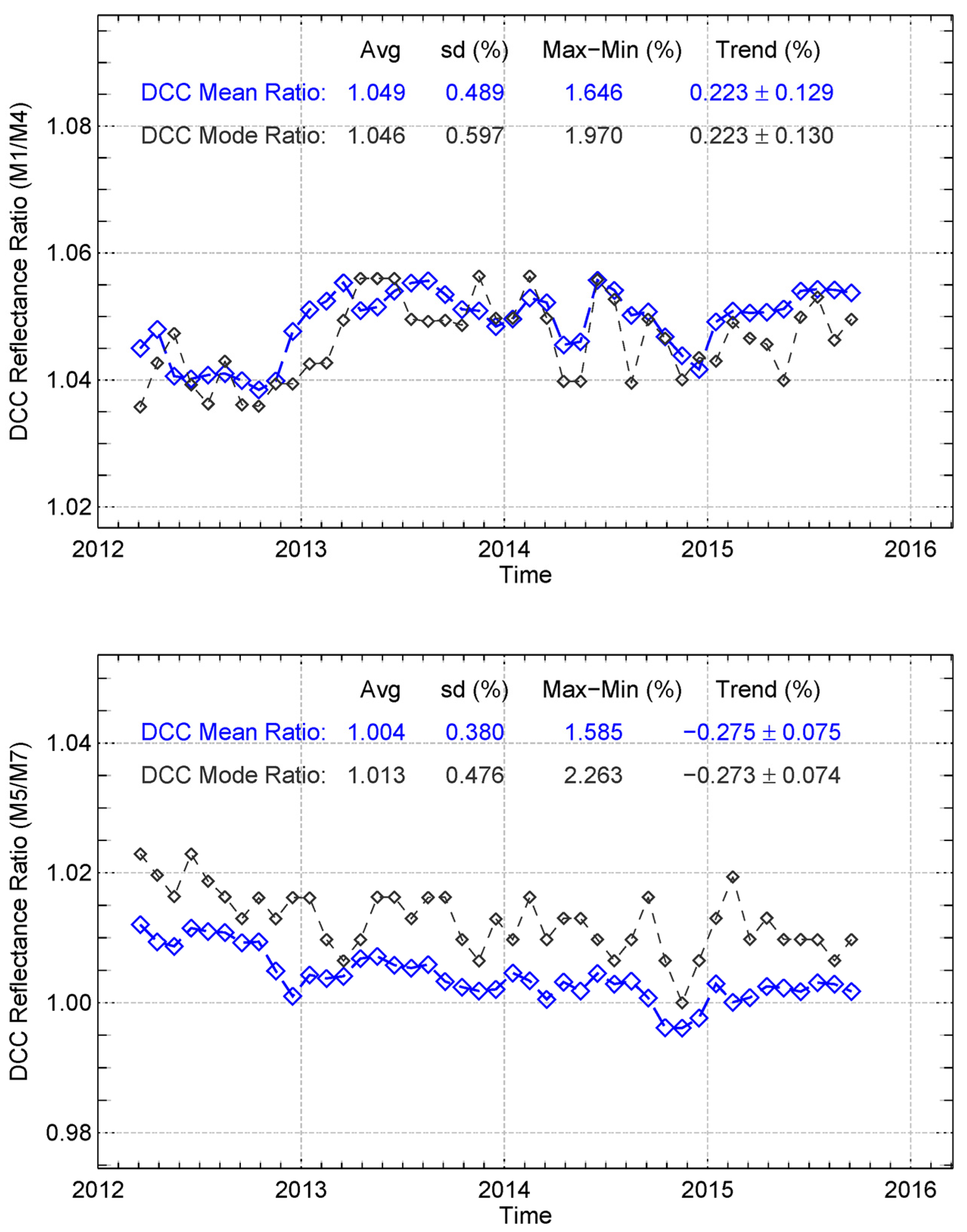
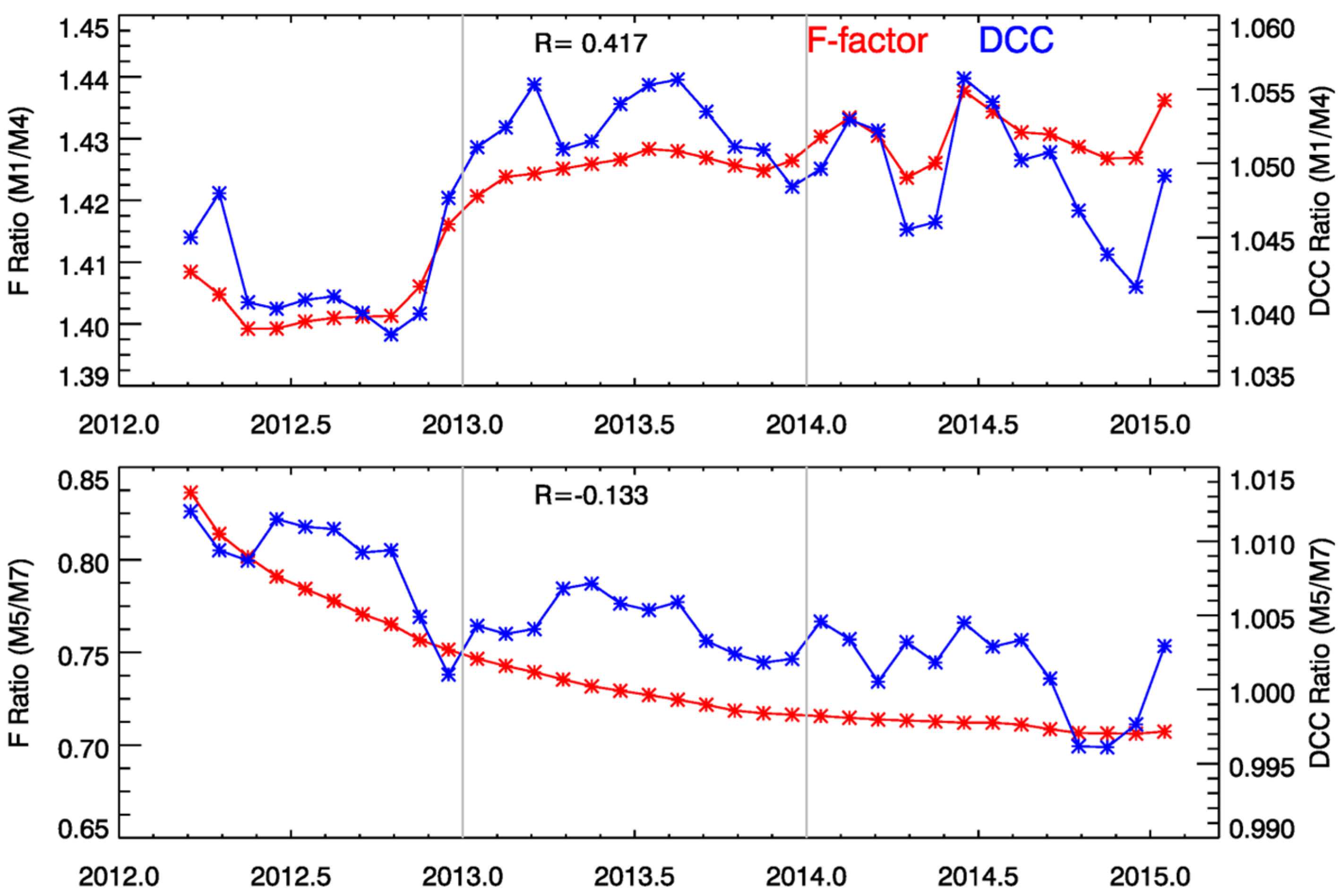
4.1.4. Comparing DCC Time Series with MODIS/VIIRS SNO-x Time Series

4.2. Calibration Stability for DNB LGS
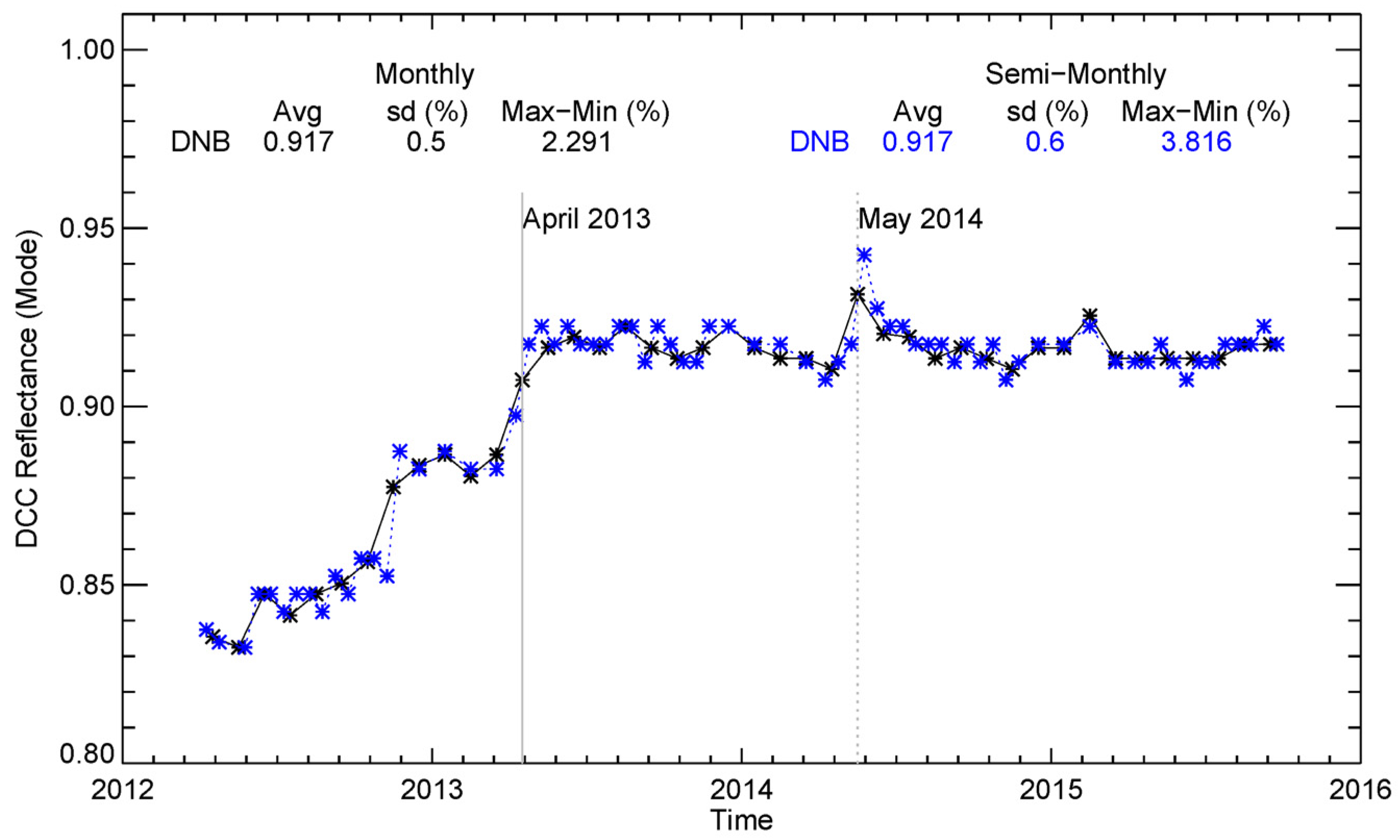
4.3. Calibration Stability for SWIR M-Bands
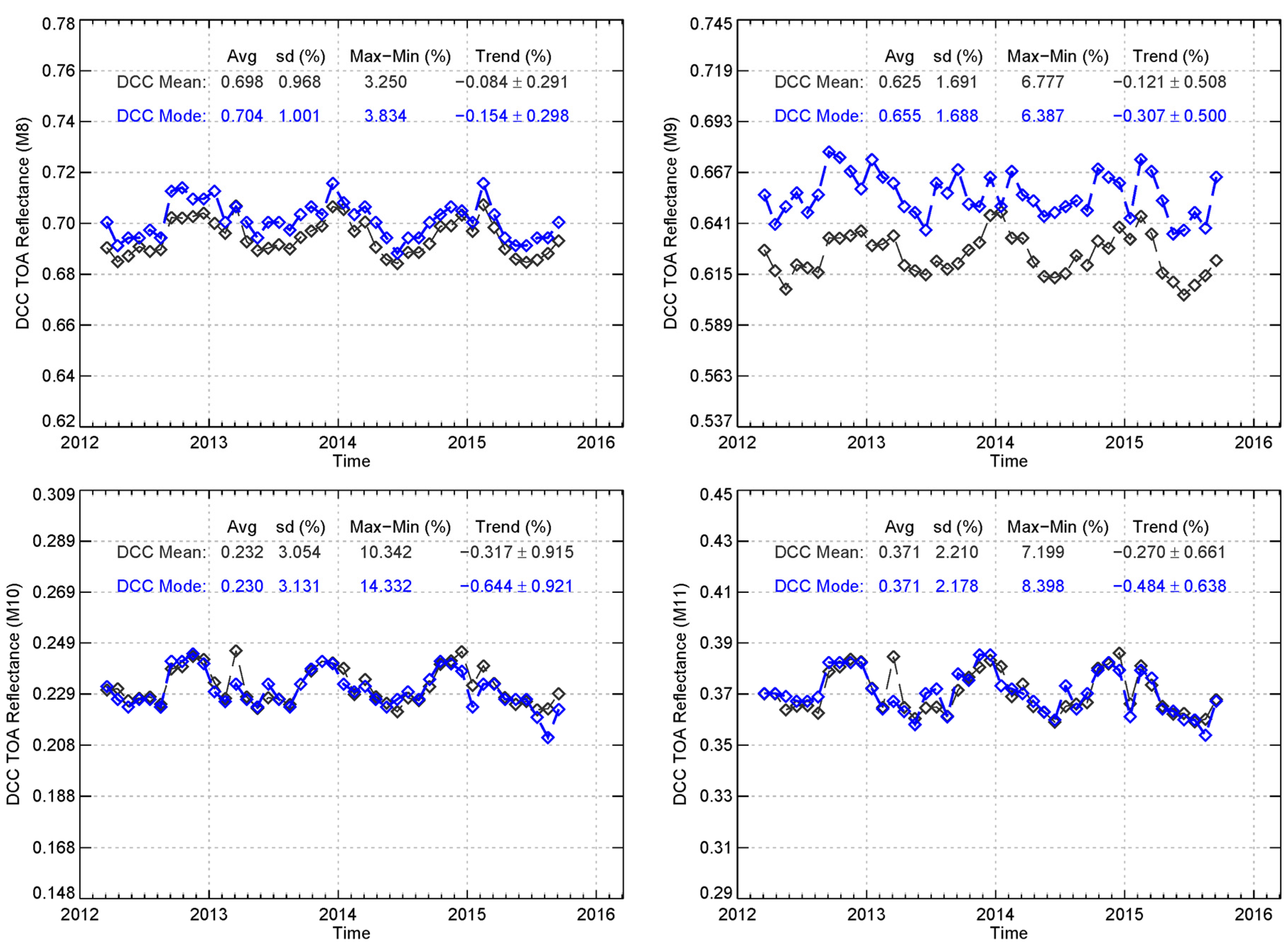
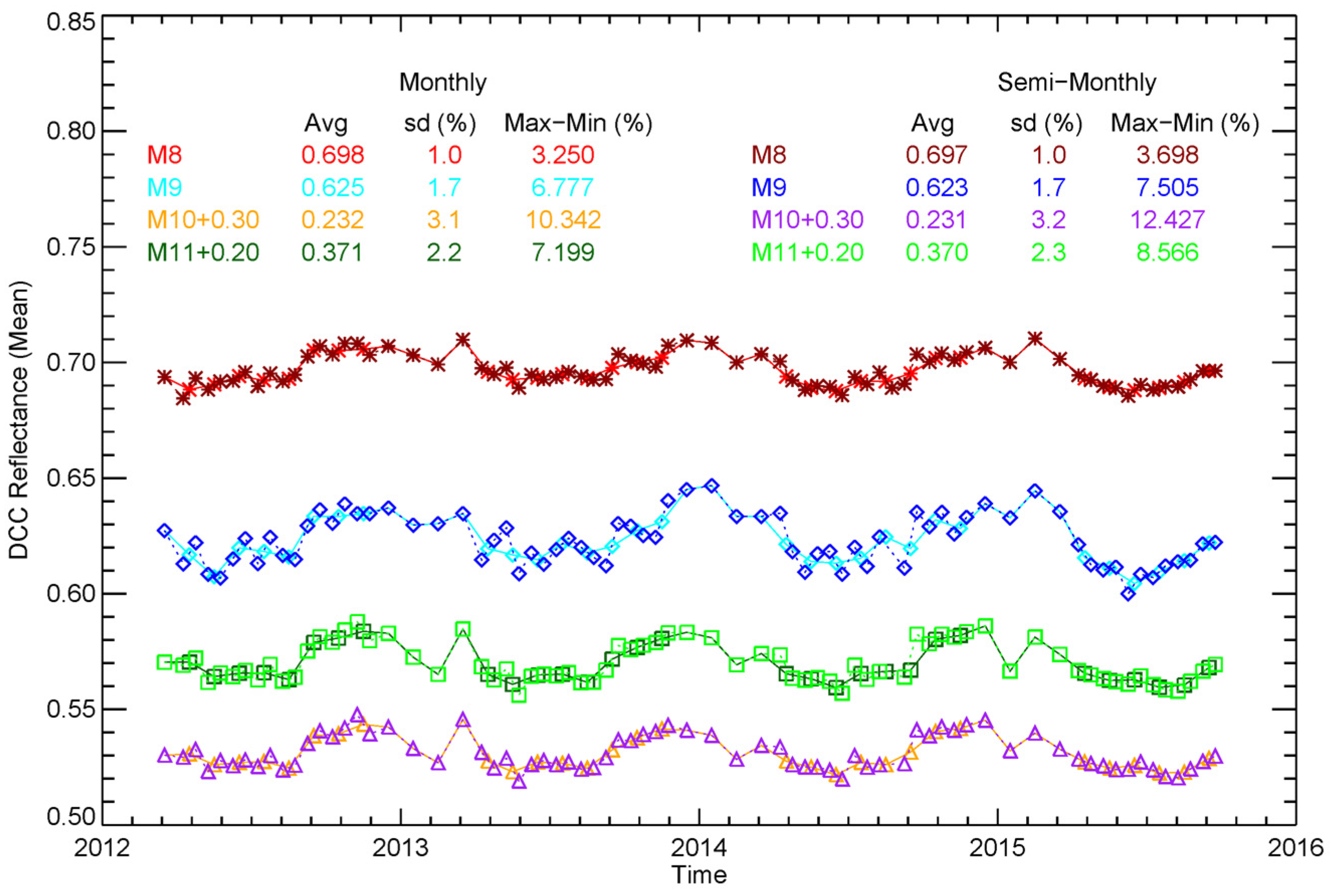
4.4. Calibration Stability for RSB I-Bands

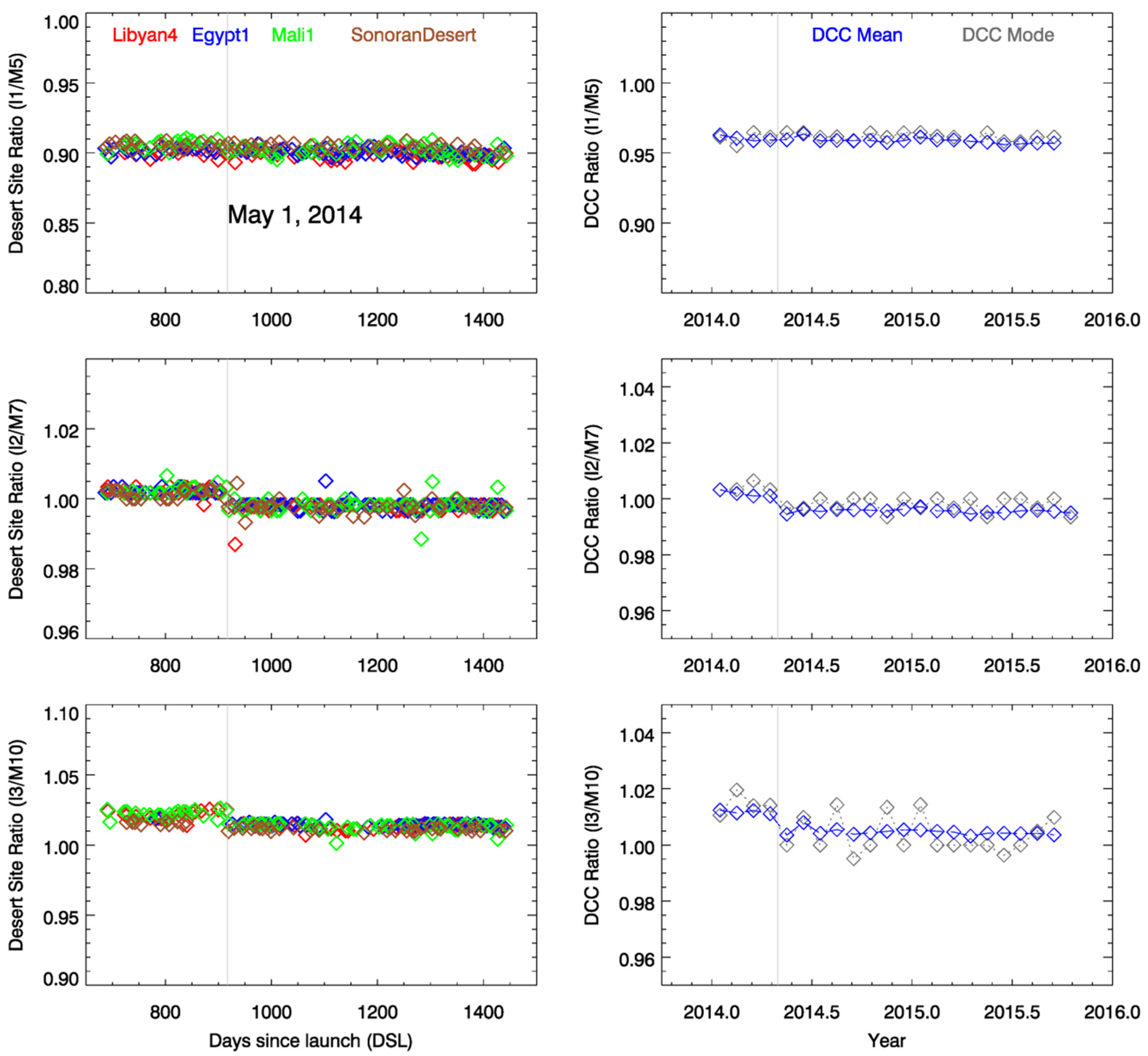
5. Summary and Conclusions
Acknowledgments
Author Contributions
Conflicts of Interest
References
- Cao, C.; de Luccia, F.J.; Xiong, X.; Wolfe, R.; Weng, F. Early on-orbit performance of the Visible Infrared Imaging Radiometer Suite onboard the Suomi National Polar-Orbiting Partnership (S-NPP) satellite. IEEE Trans. Geosci. Remote Sens. 2014, 52, 1142–1156. [Google Scholar] [CrossRef]
- Cao, C.; Xiong, J.; Blonski, S.; Liu, Q.; Uprety, S.; Shao, X.; Bai, Y.; Weng, F. Suomi NPP VIIRS sensor data record verification, validation, and long-term performance monitoring. J. Geophys. Res. Atmos. 2013. [Google Scholar] [CrossRef]
- Cardema, J.C.; Rausch, K.W.; Lei, N.; Moyer, D.I.; de Luccia, F.J. Operational calibration of VIIRS reflective solar band sensor data records. Proc. SPIE 2012, 8510. [Google Scholar]
- Moy, G.; Rausch, K.; Haas, E.; Wilkinson, T.; Cardema, J.; de Luccia, F. Mission history of reflective solar band calibration performance of VIIRS. Proc. SPIE 2015, 9607. [Google Scholar]
- Liao, L.B.; Weiss, S.; Mills, S.; Hauss, B. Suomi NPP VIIRS day-night band on-orbit performance. J. Geophys. Res. Atmos. 2013, 118. [Google Scholar] [CrossRef]
- Chen, X.; Nordhaus, W. A test of the new VIIRS lights data set: Population and economic output in Africa. Remote Sens. 2015, 7, 4937. [Google Scholar] [CrossRef]
- Shi, K.; Yu, B.; Huang, Y.; Hu, Y.; Yin, B.; Chen, Z.; Chen, L.; Wu, J. Evaluating the ability of NPP-VIIRS nighttime light data to estimate the gross domestic product and the electric power consumption of China at multiple scales: A comparison with DMSP-OLS data. Remote Sens. 2014, 6, 1705. [Google Scholar] [CrossRef]
- Johnson, R.S.; Zhang, J.; Hyer, E.J.; Miller, S.D.; Reid, J.S. Preliminary investigations toward nighttime aerosol optical depth retrievals from the VIIRS Day/Night Band. Atmos. Meas. Technol. 2013, 6, 1245–1255. [Google Scholar] [CrossRef]
- Uprety, S.; Cao, C.; Xiong, X.; Blonski, S.; Wu, A.; Shao, X. Radiometric inter-comparison between Suomi NPP VIIRS and Aqua MODIS reflective solar bands using simultaneous nadir overpass in the low latitudes. J. Atmos. Ocean. Technol. 2013, 30, 2720–2736. [Google Scholar] [CrossRef]
- Uprety, S.; Cao, C. Suomi NPP VIIRS reflective solar band on-orbit radiometric stability and accuracy assessment using desert and Antarctica Dome C sites. Remote Sens. Environ. 2015, 166, 106–115. [Google Scholar] [CrossRef]
- Wang, W.; Cao, C. Assessing the VIIRS RSB calibration stability using deep convective clouds. Proc. SPIE 2014, 9264. [Google Scholar]
- Ma, S.; Yan, W.; Huang, Y.-X.; Ai, W.-H.; Zhao, X. Vicarious calibration of S-NPP/VIIRS day-night band using deep convective clouds. Remote Sens. Environ. 2015, 158, 42–55. [Google Scholar] [CrossRef]
- Cao, C.; Bai, Y. Quantitative analysis of VIIRS DNB nightlight point source for light power estimation and stability monitoring. Remote Sens. 2014, 6, 11915–11935. [Google Scholar] [CrossRef]
- Wang, W.; Cao, C. DCC radiometric sensitivity to spatial resolution, cluster size, and LWIR calibration bias sased on VIIRS observations. J. Atmos. Ocean. Technol. 2015, 32, 48–60. [Google Scholar] [CrossRef]
- Hu, Y.; Wielicki, B.A.; Ping, Y.; Stackhouse, P.W., Jr.; Lin, B.; Young, D.F. Application of deep convective cloud albedo observation to satellite-based study of the terrestrial atmosphere: Monitoring the stability of spaceborne measurements and assessing absorption anomaly. IEEE Trans. Geosci. Remote Sens. 2004, 42, 2594–2599. [Google Scholar]
- Doelling, D.R.; Minnis, P.; Nguyen, L. On the use of deep convective clouds to calibrate AVHRR data. In Proceedings of the International Symposium on Optical Science and Technology SPIE 49th Annual Meeting, Denver, CO, USA, 2–6 August 2004.
- Doelling, D.R.; Morstad, D.; Scarino, B.R.; Bhatt, R.; Gopalan, A. The characterization of deep convective clouds as an invariant calibration target and as a visible calibration technique. IEEE Trans. Geosci. Remote Sens. 2013, 51, 1147–1159. [Google Scholar] [CrossRef]
- Minnis, P.; Doelling, D.R.; Nguyen, L.; Miller, W.F.; Chakrapani, V. Assessment of the visible channel calibrations of the VIRS on TRMM and MODIS on Aqua and Terra. J. Atmos. Ocean. Technol. 2008, 25, 385–400. [Google Scholar] [CrossRef]
- Fougnie, B.; Bach, R. Monitoring of radiometric sensitivity changes of space sensors using deep convective clouds: Operational application to PARASOL. IEEE Trans. Geosci. Remote Sens. 2009, 47, 851–861. [Google Scholar] [CrossRef]
- Bhatt, R.; Doelling, D.; Wu, A.; Xiong, X.; Scarino, B.; Haney, C.; Gopalan, A. Initial stability assessment of S-NPP VIIRS reflective solar band calibration using invariant desert and deep convective cloud targets. Remote Sens. 2014, 6, 2809. [Google Scholar] [CrossRef]
- Aumann, H.H.; Pagano, T.; Hofstadter, M. Observations of deep convective clouds as stable reflected light standard for climate research: AIRS evaluation. SPIE 2007, 6684. [Google Scholar]
- Loeb, N.G.; Kato, S.; Loukachine, K.; Manalo-Smith, N. Angular distribution models for top-of-atmosphere radiative flux estimation from the Clouds and the Earth’s Radiant Energy System instrument on the Terra satellite part I: Methodology. J. Atmos. Ocean. Technol. 2005, 22, 338–351. [Google Scholar] [CrossRef]
- Blonski, S.; Cao, C.; Shao, X.; Uprety, S. VIIRS reflective solar bands calibration changes and potential impacts on ocean color applications. Proc. SPIE 2014, 9111. [Google Scholar]
- Fulbright, J.P.; Lei, N.; McIntire, J.; Efremova, B.; Chen, X.; Xiong, X. Improving the characterization and performance of the Suomi-NPP VIIRS solar diffuser stability monitor. Proc. SPIE 2013, 8866. [Google Scholar]
- Wang, M.; Liu, X.; Tan, L.; Jiang, L.; Son, S.; Shi, W.; Rausch, K.; Voss, K. Impacts of VIIRS SDR performance on ocean color products. J. Geophys. Res. Atmos. 2013, 118, 10347–10360. [Google Scholar] [CrossRef]
- Lei, N.; Wang, Z.; Guenther, B.; Xiong, X.; Gleason, J. Modeling the detector radiometric response gains of the Suomi NPP VIIRS reflective solar bands. Proc. SPIE 2012, 8533. [Google Scholar]
- Minnis, P.; Hong, G.; Ayers, J.K.; Smith, W.L.; Yost, C.R.; Heymsfield, A.J.; Heymsfield, G.M.; Hlavka, D.L.; King, M.D.; Korn, E.; et al. Simulations of infrared radiances over a deep convective cloud system observed during TC4: Potential for enhancing nocturnal ice cloud retrievals. Remote Sens. 2012, 4, 3022. [Google Scholar] [CrossRef]
- Wang, W.; Cao, C.; Uprety, S.; Bai, Y.; Padula, F.; Shao, X. Developing an automated global validation site time series system for VIIRS. Proc. SPIE 2014, 9218. [Google Scholar]
- SNPP VIIRS Validation Site Time Series. Available online: http://ncc.nesdis.noaa.gov/VIIRS/VSTS.php (accessed on 30 October 2015).
© 2016 by the authors; licensee MDPI, Basel, Switzerland. This article is an open access article distributed under the terms and conditions of the Creative Commons by Attribution (CC-BY) license (http://creativecommons.org/licenses/by/4.0/).
Share and Cite
Wang, W.; Cao, C. Monitoring the NOAA Operational VIIRS RSB and DNB Calibration Stability Using Monthly and Semi-Monthly Deep Convective Clouds Time Series. Remote Sens. 2016, 8, 32. https://doi.org/10.3390/rs8010032
Wang W, Cao C. Monitoring the NOAA Operational VIIRS RSB and DNB Calibration Stability Using Monthly and Semi-Monthly Deep Convective Clouds Time Series. Remote Sensing. 2016; 8(1):32. https://doi.org/10.3390/rs8010032
Chicago/Turabian StyleWang, Wenhui, and Changyong Cao. 2016. "Monitoring the NOAA Operational VIIRS RSB and DNB Calibration Stability Using Monthly and Semi-Monthly Deep Convective Clouds Time Series" Remote Sensing 8, no. 1: 32. https://doi.org/10.3390/rs8010032
APA StyleWang, W., & Cao, C. (2016). Monitoring the NOAA Operational VIIRS RSB and DNB Calibration Stability Using Monthly and Semi-Monthly Deep Convective Clouds Time Series. Remote Sensing, 8(1), 32. https://doi.org/10.3390/rs8010032








